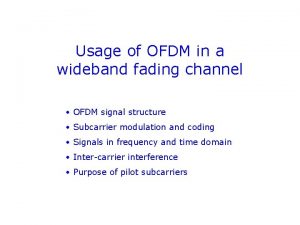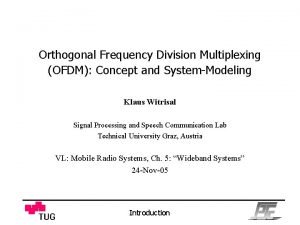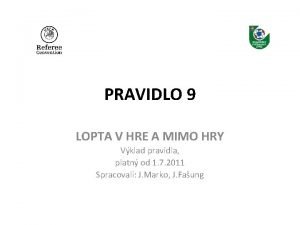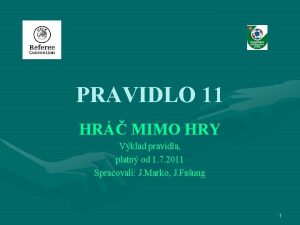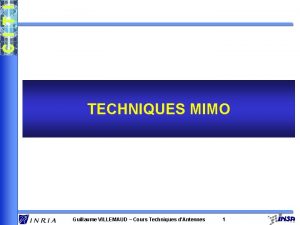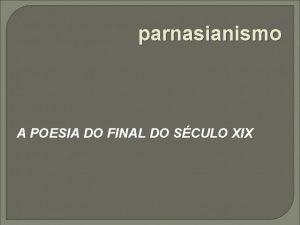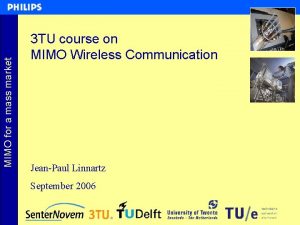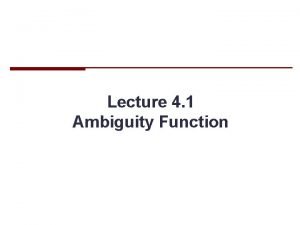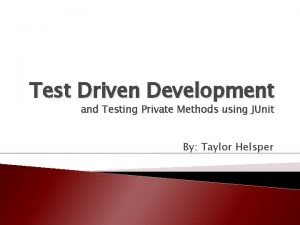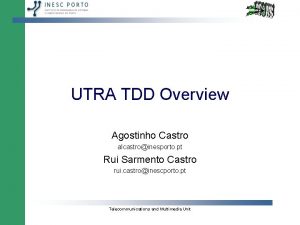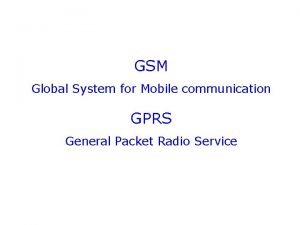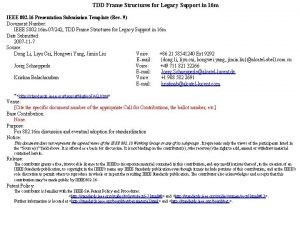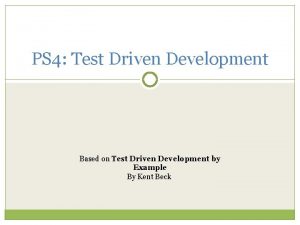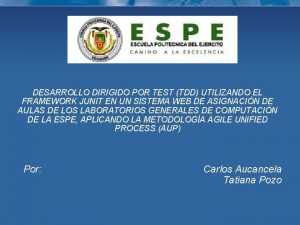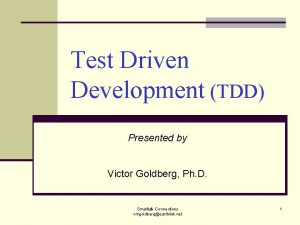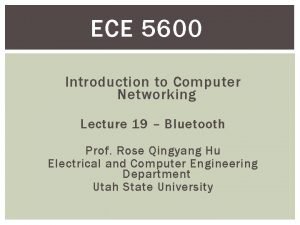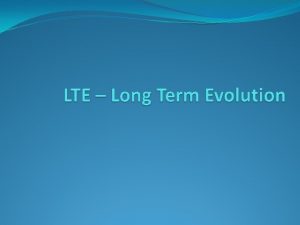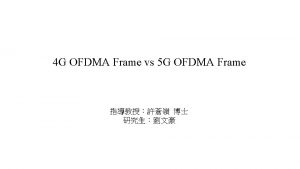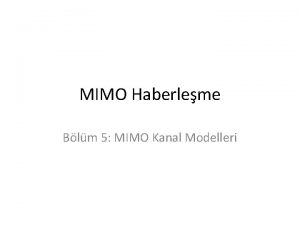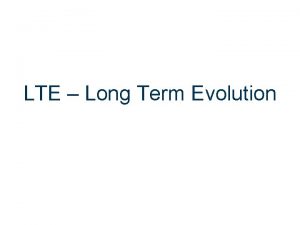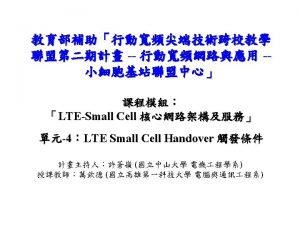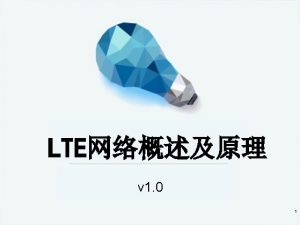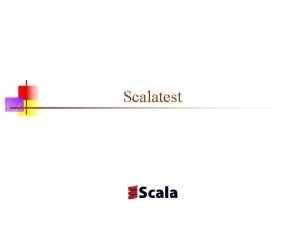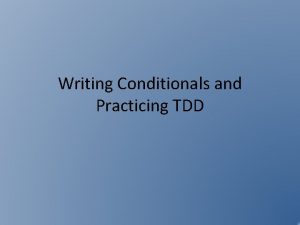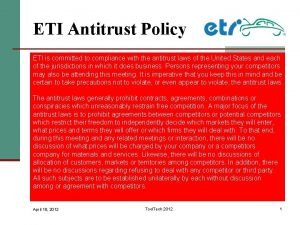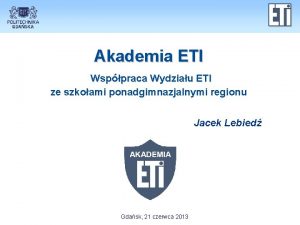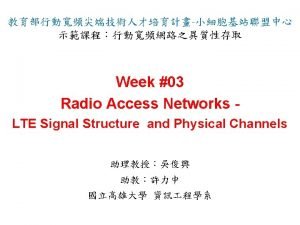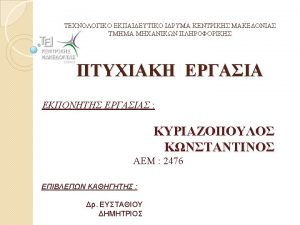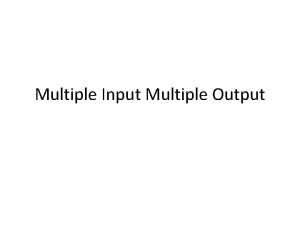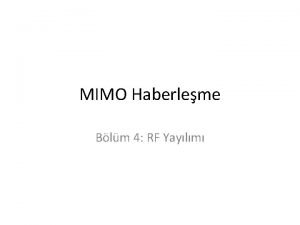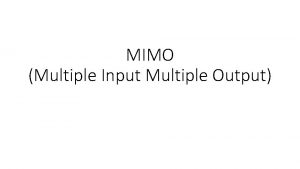INTRODUCTION TO LTE MIMO LTE TDD OFDMA ETI
























- Slides: 24

INTRODUCTION TO LTE MIMO, LTE TDD & OFDMA ETI 2511 – COMMUNICATION SYSTEMS II Monday, 09 November 2015 1

WHY USE OF DIVERSITY? 1. Diversity provides the receiver with multiple versions of the same signal. 2. If the versions are affected in different ways by the signal path, then probability that they will all be affected at the same time is considerably reduced. 3. Diversity can therefore be used to stabilise a link and improve performance, and reducing error rate. 2

TYPES OF DIVERSITY 1. Time diversity: A message is transmitted at different times, e. g. using different timeslots. 2. Frequency diversity: Different frequencies are used to transmit the same message. It may be in the form of using different channels, or technologies such as spread spectrum / OFDM. 3. Space diversity: Uses antennas located in different positions to take advantage of the different radio paths that exist in a typical terrestrial environment. 3

WHAT IS MIMO? 1. Multiple Input Multiple Output (MIMO) uses multiple antennas to make use of reflected signals to provide gains in channel robustness and throughput. 2. It is one of the major LTE technology innovations used to improve the performance. 4

TYPES OF DIVERSITY USED IN MIMO There are two main categories diversity used in MIMO: 1. Spatial diversity: Refers to transmit and receive diversity. Used to provide improvements in the signal to noise ratio and they are characterised by improving the reliability of the system in the presence of fading. 2. Spatial multiplexing: Used to provide additional data capacity by utilising the different paths to carry additional traffic, i. e. increasing the data throughput capability. 5

MIMO APPLICATION IN LTE 1. LTE MIMO system has more than one antenna at the transmitter and at the receiver. 2. LTE MIMO uses the processing power available at either end of the link to utilise the different paths that exist between the two entities to provide improvements in data rate by setting up multiple data streams. 6

LTE DUPLEX SCHEMES ETI 2511 Monday, 09 November 2015 7

WHY DUPLEX SCHEMES? (1) 1. A Duplex Scheme is essential in any cellular communications system to allow transmission in both directions simultaneously: a) For Voice, to enable either end to talk and listen as required; and b) For data, to support virtually simultaneous or completely simultaneous data transmission in both directions. 2. A duplex scheme therefore provides a way of organizing the transmitter and receiver so that they can transmit and receive as required. 8

BLOCK DIAGRAM OF 2 ND GENERATION FDD DUPLEXER 890 -915 MHz 935 -960 MHz 9

LTE DUPLEX SCHEME LTE was designed to accommodate two types of duplex schemes: (a) Paired spectrum for Frequency Division Duplex (FDD), and (b) Unpaired spectrum for Time Division Duplex (TDD). 10

COMPARISON BETWEEN LTE-TDD & LTE-FDD (1) PARAMETER LTE-TDD LTE-FDD 1. Paired spectrum Does not require paired spectrum as both transmit and receive occur on the same channel Requires paired spectrum with sufficient frequency separation to allow simultaneous transmission and reception 2. Hardware cost (a) Lower cost as no diplexer is needed to isolate the transmitter and receiver. Diplexer is needed and cost is higher. 3. Channel reciprocity 4. UL / DL asymmetry (b) As cost of the UEs is of major importance because of the vast numbers that are produced, this is a key aspect. Channel propagation is the same in both Channel characteristics different in both directions which enables transmit and receive directions as a result of the use of different to use on same set of parameters frequencies It is possible to dynamically change the UL and DL capacity ratio to match demand (a) UL / DL capacity determined by frequency allocation set out by the regulatory authorities. (b) It is not possible to make dynamic changes to match capacity. (c) Regulatory changes would normally be required to increase capacity. (d) Capacity is normally allocated so that it is the same in either direction. 11

COMPARISON BETWEEN LTE-TDD & LTE-FDD (2) PARAMETER 5. Guard Period/ Guard band LTE-TDD Guard period required to ensure uplink and downlink transmissions do not clash. Large guard period will limit capacity. LTE-FDD Guard band required to provide sufficient isolation between uplink and downlink bands. Larger guard period normally required if distances are increased to accommodate larger propagation times. 6. Discontinuous transmission Only Discontinuous transmission is supported to allow both uplink and downlink transmissions. Continuous transmission is supported This can degrade the performance of the RF power amplifier in the transmitter. 7. Cross slot interference Base stations need to be synchronised with respect to the uplink and downlink transmission times. Not applicable If neighbouring base stations use different uplink and downlink assignments and share the same channel, then interference may occur between cells. 12

LTE OFDMA ITE 2511 – WIRELESS SYSTEMS II Monday, 09 November 2015 13

CLASSICAL FDM 1. When modulation of any form - voice, data, etc. is applied to a carrier, the sidebands spread out either side of the carrier. 2. As a result when signals are transmitted close to one another they must be spaced so that the receiver can separate them using a filter, i. e there must be a guard band between them. 14

WHAT IS OFDM? 1. Orthogonal Frequency Division Multiplexing (OFDM) is a subset of frequency division multiplexing in which a single channel utilizes multiple sub-carriers on adjacent frequencies. 2. Neighbouring Sub-carriers in an OFDM system are orthogonal to one another. 3. Being orthogonal allows the sub-carriers to overlap without causing interference thus ensuring high spectral efficiency. 15

LIMITING INTERFERENCE FROM SIDEBANDS 1. In OFDM the sidebands are orthogonal to each other. 2. Although the sidebands from each carrier overlap, they can still be received without the interference that might be expected. 3. OFDM is achieved by having the carrier spacing equal to the reciprocal of the symbol period. 16

TRANSMITTING DATA USING OFDM 1. The data to be transmitted on an OFDM signal is spread across the subcarriers, i. e each subcarrier only taking part of the payload. 2. This reduces the data rate taken by each carrier. 3. The lower data rate has the advantage that interference from reflections is reduced. 4. The reduced data rate allows for the introduction of a guard band time or guard interval into the system. 5. The Guard Interval ensures that the data is only sampled when the signal is stable and no new delayed signals arrive that would alter the timing and phase of the signal. 17

WHY OFDM OVERCOMES MULTIPATH EFFECT 1. The distribution of the data across a large number of subcarriers in the OFDM signal allows the system to overcome the multipath effect. 2. Nulls caused by multi-path effects or interference on a given frequency usually affect a small number of the carriers, the remaining ones being received correctly. 3. By using error-coding techniques, which requires adding further data to the transmitted signal, most or all of the corrupted data to be reconstructed within the receiver. 4. This can be done because the error correction code is transmitted in a different sub-carrier. 18

OFDM ADVANTAGES OFDM is used in high data rate wireless systems because of the following advantages: 1. Immunity to selective fading: OFDM is more resistant to frequency selective fading than single carrier systems because it divides the overall channel into multiple narrowband signals that are affected individually by fading. 2. Resilience to interference: Interference appearing on a channel may be bandwidth limited and in this way will not affect all the sub-channels. This means that not all the data is lost. 3. Spectrum efficiency: By using close-spaced overlapping sub-carriers it makes efficient use of the available spectrum. 4. Resilient to ISI: By supporting low data rates in each sub-channel, OFDMA is resilient to inter-symbol and inter-frame interference. 5. Resilient to narrow-band effects: Using adequate channel coding and interleaving it is possible to recover symbols lost due to the frequency selectivity of the channel and narrow band interference. 6. Simpler channel equalisation: One of the issues with CDMA systems was the complexity of the channel equalisation which had to be applied across the whole channel, i. e 20 MHz. An advantage of OFDM is that using multiple sub 19 channels, the channel equalization becomes much simpler.

APPLICATIONS OF OFDM Apart from LTE, other common protocols that employ OFDM include: 1. Digital Video Broadcast (DVB), 2. Asymmetric Digital Subscriber Line (ADSL), 3. Wireless Ethernet (Wi. FI) 20

DIGITAL SUBSCRIBER LINE (DSL) 1. DSL takes advantage of this unused bandwidth of the local loop by creating 4, 312. 5 Hz wide channels. 2. Allocation of channels continues at higher and higher frequencies (up to 1. 1 MHz for ADSL) until additional channels are deemed unusable. 21

OFDM IMPLEMENTATION IN Wi. Fi 1. Wi. FI implementations specifically use OFDM techniques. 2. Each Wi. Fi channel occupies 16. 25 MHz of bandwidth at the 2. 4 GHz frequency range. 3. Each channel is divided into 52 sub-carriers of 312. 5 k. Hz. 4. These sub-carriers overlap to fully utilize the 16. 25 MHz channel bandwidth dedicated per channel. 5. In addition, each sub-carrier can use a unique modulation scheme. 6. Wi. FI can use BPS, QPSK, 16 -QAM, or 64 -QAM depending on the characteristics of the physical channel. 22

OFDM IMPLEMENTATION IN Wi. MAX(1) 1. Wi. MAX, or IEEE 802. 16, is an internet communications protocol specifically designed to provide internet access across long wireless communications links. 2. Wi. MAX can have data throughputs of up to 75 Mbps and operates in the 2. 5 GHz, 3. 5 GHz, and 5. 8 GHz bands. 3. Wi. MAX utilizes the OFDM. It is therefore more resilient to multi-path symbol interference and can be used to transmit data distances of up to 50 Kms 23

OFDM IMPLEMENTATION IN Wi. MAX(2) 4. Each Wi. MAx OFDM channel consists of 128 to 2048 sub-carriers and can occupy bandwidths from 1. 25 MHz to 20 MHz. 5. Each of these sub-carriers is modulated using BPSK, QPSK, 16 -QAM, or 64 -QAM modulation, depending on the requirements of the physical channel. 24
 Fdma vs ofdma
Fdma vs ofdma Ofdma block diagram
Ofdma block diagram Ofdma block diagram
Ofdma block diagram Lopta mimo hry
Lopta mimo hry Postavenie mimo hry
Postavenie mimo hry Memo ama a ema
Memo ama a ema Cours mimo
Cours mimo Mayamimo
Mayamimo Alberto de oliveira parnasianismo
Alberto de oliveira parnasianismo (mackenzie) não caracteriza a estética parnasiana:
(mackenzie) não caracteriza a estética parnasiana: Mimi teocrito
Mimi teocrito Mimo for dummies
Mimo for dummies Mimo
Mimo Junit test private methods
Junit test private methods Tdd
Tdd Tdd exercises
Tdd exercises Msc gsm
Msc gsm Cellulite génienne
Cellulite génienne Frame duration flexible legacy
Frame duration flexible legacy Tdd pros and cons
Tdd pros and cons Tdd ciclo
Tdd ciclo Tdd aaa
Tdd aaa Smalltalk
Smalltalk Tdd tutorial java
Tdd tutorial java Tdd
Tdd

